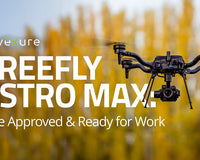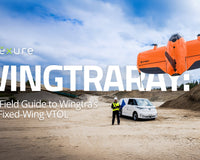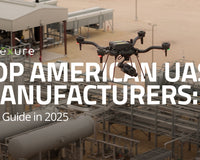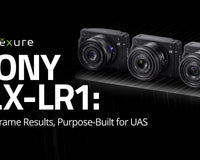Precision agriculture has advanced rapidly over the last few years, and multispectral drone technology is now a key driver of data-based farming decisions. While spray drones often grab headlines for automating tasks like seeding or chemical application, they’re not built for detailed crop analysis.
In this blog, we’ll tackle a growing question for farms, orchards, and ag research: Is the Mavic 3 Multispectral (M3M) the top drone for precision agriculture in 2025? We’ll compare its features—like the included RTK module, built-in sunlight sensor, and RGB mapping camera—to those of competing solutions such as MicaSense Red-Edge P, Sentera 6X, and the ACSL SOTEN Multispectral. Along the way, we’ll examine each platform’s sensor quality, spectral coverage, ease of use, and overall cost.
By the end, you’ll have a solid grasp of the M3M’s strengths, weaknesses, and where alternatives might be better suited, helping you decide if it’s the right choice to support your operation’s agricultural intelligence needs.
Seeing the Unseen: The Power of Multispectral Imaging
Understanding Multispectral Imaging
At its core, multispectral imaging involves capturing light beyond what the human eye can detect—particularly in the near-infrared (NIR) range. Plants reflect and absorb specific wavelengths depending on their health, so having a multispectral camera on your agricultural drone lets you detect early signs of stress, disease, or nutrient deficiencies that aren’t visible in standard RGB photos. Armed with this information, you can make timely decisions about irrigation, fertilization, or pest control.

Multispectral Bands and What They Tell Us
Modern multispectral sensors measure various slices of the electromagnetic spectrum. Here’s a quick look at the bands typically used in agriculture and why they matter:
| Spectral Band | Wave Length | Application |
| Near-Infrared (NIR) | 750-950 nm | Essential for biomass and canopy density studies |
| Red Edge | 700-740 nm | Indicates early vegetation stress |
| Red | 620-750 nm | Useful for assessing plant health |
| Green | 495-570 nm | Reflects plant vigor and chlorophyll content |
| Blue | 450-495 nm | Enhanced for water and vegetation analysis |
Vegetation Indices Explained
Multispectral imaging data is often processed into vegetation indices, which highlight specific plant health characteristics. Here’s a quick rundown of the most commonly used indices:
| Index | Description | Use Cases | Formula |
| NDVI |
Normalized Difference Vegetation Index: Measures vegetation health by comparing NIR and Red light. |
Identifying healthy vegetation vs. stressed or dead plants. |
(NIR - Red) / (NIR + Red) |
| NDRE |
Normalized Difference Red Edge: Focuses on chlorophyll content in leaves. |
Early detection of nitrogen deficiencies. |
(NIR - Red Edge) / (NIR + Red Edge) |
| OSAVI |
Optimized Soil Adjusted Vegetation Index: Reduces soil brightness interference. |
Assessing sparse vegetation and soil conditions. |
(NIR - Red) / (NIR + Red + 0.16)
|
| GNDVI |
Green Normalized Difference Vegetation Index: Uses Green and NIR to highlight plant vigor. |
Monitoring chlorophyll and nutrient uptake. |
Identifying healthy vegetation vs. stressed or dead plants.(NIR - Green) / (NIR + Green) |
Each index is designed to provide unique insights. NDRE might be your go-to if you suspect nitrogen deficiencies, while OSAVI is handy when you’re dealing with reflective or patchy soil conditions.
Why Use Drones?
Traditional ground scouting can be time-consuming and might miss small problems until they spread. By contrast, drones can cover large swaths of land quickly, delivering consistent, repeatable data. This approach saves time and often reduces costs by catching issues early—whether it’s a pest outbreak in one section of a field or water stress in specific rows of an orchard.
By combining these multispectral bands and indices, growers get an accurate snapshot of crop health across entire fields, enabling smarter, data-based decisions. In the next section, we’ll see how the DJI Mavic 3 Multispectral capitalizes on these principles and where it stands among other leading solutions.
Taking Flight in 2025: DJI M3M vs. Other Leading Solutions
When it comes to precision agriculture drones and sensors, there’s no shortage of options. However, each platform meets different needs for different budgets and levels of technical complexity. Below, we’ll dive into four notable choices for collecting and analyzing multispectral data in farm, orchard, and research environments.

DJI Mavic 3 Multispectral (M3M)
Price:
$4,959.00 (Drone, integrated sensor, and standard accessories)
The DJI Mavic 3 Multispectral is a ready-to-fly system designed to make multispectral imaging more accessible and cost-effective. It pairs a 20MP RGB camera with four multispectral sensors (Green, Red, Red Edge, NIR), each at 5MP. This combination means you can capture both visible light and near-infrared data in a single flight—enabling everything from crop vigor assessments to NDVI/NDRE mapping.
Key Features:
- Integrated Sensor Suite: 20MP RGB camera with mechanical shutter for mapping + 5MP multispectral bands (G, R, RE, NIR).
- Impressive Flight Times: Up to 43 minutes in ideal conditions; typically 36–42 minutes under normal field operations. This often covers up to 500 acres in a single flight.
- Centimeter-Level Precision: An RTK module syncs with the camera’s shutter to ensure each image center is accurately geo-tagged, reducing or eliminating the need for ground control points.
- Sunlight Sensor: Measures ambient light to calibrate each image, improving data consistency across different times of day.
- Ease of Use & Compatibility: Works seamlessly with DJI Terra, DJI SmartFarm Platform, and third-party solutions (via DJI Cloud API or MSDK). Also features omnidirectional obstacle sensing and terrain-follow modes for hilly orchards or uneven farmland.

MicaSense RedEdge-P
Price:
Starts at $7,995 (Sensor only; requires a compatible drone platform such as DJI Matrice 300/350)
The MicaSense RedEdge-P is a high-end, research-grade multispectral sensor. Unlike the M3M, the RedEdge-P isn’t a drone; it’s a payload that typically mounts on enterprise aircraft like the DJI Matrice 300 or 350, which themselves can cost $12,000 or more. This makes the total system investment significantly higher.
Key Features:
- Five Narrow Bands + Panchromatic: Bands for Blue, Green, Red, Red Edge, and NIR, plus a high-resolution panchromatic channel that can achieve 2cm ground sampling distance (GSD) at 200 ft.
- Pan-Sharpened Outputs: The panchromatic band sharpens the multispectral images, revealing fine details critical for advanced crop research.
- Calibration Essentials: Every kit includes a reflectance panel and a DLS2 light sensor, Open Data Workflow: The raw data is easily processed using common GIS and photogrammetry software, making it ideal for university research, advanced analytics firms, and agronomic service providers.
Who It’s For:
If you need blue band coverage or extremely detailed panchromatic data—for instance, to detect minor pest infestations or early disease stress—RedEdge-P is a powerful option. However, the combined cost of the sensor and a compatible drone platform can surpass $20,000–$30,000. Large operations with dedicated research goals or specialized consulting services may find this level of detail worth the extra expense and complexity.

Sentera 6X Multispectral
Price:
Starts at $12,000 (Sensor only; typically mounted on DJI Matrice 300/350 or other enterprise platforms)
The Sentera 6X is another sensor-focused solution geared toward high-accuracy, science-grade data. Like the RedEdge-P, it must be paired with a larger drone—often the Matrice 300/350—which raises the initial investment. Still, for those who need radiometric accuracy and expanded spectral coverage (including Blue), Sentera is a proven name in the ag drone space.
Key Features:
- Multispectral + RGB in One Housing: The 6X combines five 3.2MP multispectral imagers (Blue, Green, Red, Red Edge, NIR) and a 20MP RGB camera.
- High Resolution, Fast Capture: Multispectral images at ~3cm GSD and RGB at ~1cm GSD, enabling fine detail in disease detection or crop stand counts.
- Calibration Tools: Comes with an incident light sensor and a reflectance panel to keep measurements consistent.
- Stable Enterprise Platform: Often mounted on a gimbal for reduced motion blur, resulting in clearer images even in moderate wind conditions.
Who It’s For:
Consultants, agronomists, and research institutions who demand advanced analytics—like true color plus five distinct narrow bands—will appreciate the 6X’s data quality. The trade-off is a higher price point and the operational overhead of a larger drone system.

ACSL SOTEN
Price:
$15,250.00 (Complete “Agriculture Package”)
Built in Japan, the ACSL SOTEN addresses a growing demand for NDAA-compliant hardware and secure data workflows. It’s not as commonly seen on U.S. farms as DJI or MicaSense-based setups, but it stands out for its strict security standards and flexibility.
Key Features:
- NDAA Compliance & ISO15408-Based Security: Designed to minimize the risk of data leakage and hacking, which can be essential for government projects or sensitive research.
- Swappable Cameras: Supports multiple payloads—including a 1-inch 20MP multispectral camera, EO/IR, and zoom.
- Robust Flight Performance: Max airspeed of 15 m/s and improved positional accuracy in Japanese airspace using SLAS/SBAS signals.
Who It’s For:
Organizations bound by NDAA requirements, such as government agencies or certain enterprise contractors, will find the SOTEN one of the few available options. If you need secure data handling and can invest in a slightly pricier system, it’s an alternative worth consideration. However, the broader software ecosystem is a lot less developed compared to DJI’s and the end product isn’t nearly as refined.
Which Drone or Sensor Makes Sense for You?
Budget & Simplicity: If you’re seeking a turnkey solution without spending $20,000 or more, the DJI Mavic 3 Multispectral ($4,959) is tough to beat. It offers an integrated RTK module, excellent flight times, and straightforward compatibility with farm management tools.
High-End Research: If advanced analytics—like ultra-high-resolution panchromatic data or additional spectral bands—are essential, MicaSense RedEdge-P ($7,995 + drone) or Sentera 6X ($12,000 + drone) might be worth the extra cost and complexity.
NDAA Compliance: For users who need an NDAA-compliant platform or specific security measures, the ACSL SOTEN ($15,250) delivers robust hardware and data encryption out of the box.
Maximizing Returns: Field Implementation & ROI
When it comes to putting a multispectral drone to work, the true value lies in how it helps solve real-world farming challenges. Whether you’re monitoring an orchard on rolling hillsides or surveying hundreds of acres of row crops, drones like the DJI Mavic 3 Multispectral (M3M) have the potential to transform how you detect plant stress, optimize inputs, and ultimately boost profitability.
Real-World Use Cases

Orchard Mapping & Terrain-Follow Flights
Key Challenge: Traditional ground-based scouting can miss hidden pockets of disease or pest pressure—especially in orchards with uneven terrain and dense canopies.
Drone Advantage: The M3M’s terrain-follow capabilities and omnidirectional obstacle sensing help you map large orchards even on sloped landscapes. Using NDVI or NDRE from the multispectral imagery, you can pinpoint stressed trees and address problems before they spread.
Row Crop Analysis & Variable-Rate Application

Key Challenge: Applying the same amount of fertilizer or pesticide across an entire field is often wasteful and can lead to inconsistent yields.
Drone Advantage: By generating index maps (e.g., NDVI, OSAVI, or GNDVI), you can develop prescription maps that tell application drones or ground sprayers exactly where to use more or less product. This not only saves on inputs but also promotes better environmental stewardship.
Early Pest & Disease Detection

Key Challenge: In large fields, pests or diseases can silently spread long before they’re noticed from ground-level checks, leading to significant crop loss.
Drone Advantage: Multispectral imaging can detect subtle changes in leaf reflectance—signs of an early infestation—days or even weeks before the leaves look visibly stressed. Intervening at this stage can drastically reduce the scope of treatment and preserve yield.
Agricultural Research & Trials

Key Challenge: Gathering scientific-grade data usually involves time-intensive manual measurements.
Drone Advantage: Platforms like the M3M or higher-end systems (e.g., MicaSense RedEdge-P, Sentera 6X) enable detailed plant health measurements over large research plots. Real-time comparisons of different seed varieties or fertilizer regimens become far more efficient than clipboards and visual inspections alone.
Estimating the ROI
Cost of the Drone vs. Traditional Methods
The M3M costs about $4,959—roughly the price of a mid-range ATV or a single large piece of farm equipment. Compared to paying for frequent aerial imagery from third-party providers (or relying solely on labor-intensive, on-foot scouting), owning a drone can pay for itself through saved labor and more accurate applications within a few growing seasons.
Yield Improvements & Input Savings
Real-world trials show that variable-rate fertilization, guided by accurate multispectral data, can cut input costs by 10–15% in some scenarios. Meanwhile, early detection of diseases or pests can prevent partial or even total crop failures—often recouping the drone’s cost in a single high-stakes season.
Time Efficiency & Scalability
A drone flight covering 500 acres in under an hour frees up staff for other tasks. As your farm operation grows, adding more drones or scheduling regular flights is simpler and cheaper than scaling up ground-based scouting teams. Plus, platforms like Solvi or Aerobotics' Aeroview streamline data processing—putting valuable insights in your hands fast.
Risk Management
Late detection of issues can lead to pricey interventions or irreversible damage. Multispectral drones help you catch problems early, reducing the risk of yield losses. This proactive approach adds stability to your operation’s bottom line, especially when unpredictable factors (like weather or market fluctuations) are already a concern.
The M3M’s Pros & Cons: What You Need to Know

Advantages
Integrated, All-in-One Design
Multispectral + RGB in One Flight: The M3M combines four multispectral bands (Green, Red, Red Edge, NIR) with a 20MP RGB camera that features a mechanical shutter. This allows you to collect the data you need—plant stress indicators and high-resolution color images—without switching payloads or running multiple passes.
Cost-Effective for Most Farm Operations
Upfront Pricing: At around $4,959 for the entire drone package (sensor included), the M3M is significantly more affordable than enterprise setups like the Matrice 350 paired with a high-end sensor.
Reduced Ancillary Costs: Since it’s compact and easy to deploy, you’ll also save on transportation and storage expenses.
Centimeter-Level Accuracy
Built-In RTK Module: Rather than adding a costly external RTK unit, the M3M integrates one directly. This syncs with the camera in microseconds to precisely record each image’s center, enabling reliable survey-grade results and reducing the need for ground control points.
Stable Flight Performance
Extended Flight Times: In calm conditions, the M3M can stay airborne for up to 43 minutes, making it feasible to scan up to 500 acres in a single flight.
Omnidirectional Sensing & Terrain-Follow: Built-in obstacle avoidance and the ability to maintain altitude over uneven fields help you fly safely and capture consistent data.
Straightforward Data Workflow
Open Ecosystem: The M3M works with DJI Terra, DJI SmartFarm Platform, and a wide variety of third-party software via DJI Cloud API or MSDK. This flexibility ensures the drone’s data can integrate seamlessly with your existing farm management tools.
Sunlight Sensor: Corrects for changes in ambient light, improving the accuracy of vegetation indices like NDVI or NDRE over multiple flights.
Limitations
Missing the Blue Band
Fewer Spectral Bands: While the M3M covers the core multispectral ranges for most precision ag tasks, it omits the blue band. For advanced research or certain vegetation indices that rely on blue light, you might want an alternative sensor (e.g., MicaSense RedEdge-P, Sentera 6X).
Shorter Flight Time vs. Larger Platforms
Less Endurance Under Load: Although ~40 minutes is ample for many farms, enterprise drones like the Matrice 300 can push flight times even further, particularly when carrying optimized payloads.
Batteries & Charging: For very large acreages, you’ll need multiple batteries or a charging hub on-site to minimize downtime.
Limited Upgrade Path
Single Payload Design: You can’t swap out the M3M’s camera for thermal or other specialized sensors. Larger drone platforms often have modular gimbals for varied payloads.
Potentially Too Simple for High-End Research
Basic Calibration: The M3M’s calibration system works well for commercial agriculture but may lack the advanced controls offered by dedicated sensors like the RedEdge-P or the Sentera 6X when performing rigorous academic or governmental research projects.
Regulatory & Compliance Considerations
Not NDAA-Compliant: Certain government contracts or research grants might require a non-Chinese platform, meaning the M3M might not qualify for those projects.
Where to Go From Here: Next Steps for Your Precision Ag Drone Program
For most farms seeking an affordable, user-friendly system, the DJI Mavic 3 Multispectral remains a top choice in 2025. Its integrated multispectral camera, built-in RTK, and seamless data workflow cover the majority of agronomic needs, while more specialized sensors and platforms (like MicaSense, Sentera, or ACSL) cater to unique research, regulatory, or security requirements.
At Advexure, we understand that every operation is different. Whether you’re ready to invest in the M3M or curious about other advanced solutions, our team is here to provide personalized consultations, hands-on training, and ongoing support. Get in touch to see how we can help you elevate your precision agriculture program.










